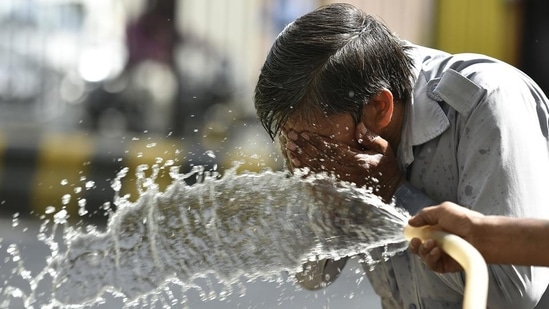0.9°C rise in peak summer temp from 1990 to 2019: Report
Peak summer temperatures in over two-thirds of India’s districts rose by up to 0.9°C between 1990 and 2019, according to a new study that warned of these trends being exacerbated due to climate change, which will also lead to more extreme weather events.
Peak summer temperatures in over two-thirds of India’s districts rose by up to 0.9°C between 1990 and 2019, according to a new study that warned of these trends being exacerbated due to climate change, which will also lead to more extreme weather events.

Precisely, the study found that average maximum temperatures between March and May rose by up to 0.9°C in 2019 in 70% of the districts in 28 states, when compared to 1990.
The results were published on Friday in a report, titled “Climate Atlas of India: District-Level Analysis of Historical and Projected Climate Change Scenarios”, which also warned of a rise in extreme weather events, particularly spells of heavy rain, if global emissions are not curbed.
The assessment provides a rare and granular look at how and where the climate crisis is unfolding in India, identifying districts where summers were harsher, winters warmer and the monsoon rainier than before. Based on these, it predicted a “warmer and wetter future” for almost the whole of India in the short term future between 2021 and 2050, a period it called as the 2030s.
The researchers did so by analysing historical trends in summer maximum and winter minimum temperatures, and rainfall in the three decades between 1990 and 2019.
ALSO READ: Rising temperatures hold a dire warning
In the winter months of December to February, the average minimum temperatures rose by up to 0.5°C in 54% of the districts in the three-decade period. There was more monsoon rain over most districts, but the north-east and Western Ghats recording the highest increase of about 10-15%.
The projected changes in climate across the country could adversely impact water, agriculture, forest and biodiversity, and health and infrastructure, the report said.
In moderate and high emissions scenarios, the report projected a warming of 1-2.5°C for the summer months in a majority of districts in 2030s. In the winter months, a warming of over 1°C is projected.
A warming of 1 to 1.5°C is projected for 72% of India’s districts, 1.5 to 2°C for 15% of the districts, 2 to 2.5°C for 2% of the districts, and 1°C for 11% of the districts.
According to the report, districts in Manipur were at the highest risk of warming with a maximum rise of 2 to 2.5°C in districts such as Bishnupur, Churachandpur, Chandel, and Noney in a moderate emission scenario up to 2030s.
The ministry of earth sciences, in a report in 2020, found that India’s average temperature rose by around 0.7 degrees Celsius between 1901 and 2019. By the end of the century, the report projected an approximate rise of 4.4 degrees Celsius in a high emissions scenario.
It also projected a rise in extreme rainfall events.
The CSTEP report has projected monsoon rain to increase by 25-35% in 2% of India’s districts, 15-25% in 18% of districts, and 10-15% in 35% of the districts relative to the 1990-2019 period.
In the remaining 45% of the districts, less than 10% change in rainfall is projected.
An increase of 25-35% in rainfall is projected for only a few districts in Maharashtra, Madhya Pradesh, Uttar Pradesh, Gujarat, and Bihar. An increase of 15-25% is projected for only a few districts in the states of Arunachal Pradesh, Chhattisgarh, Gujarat, Tamil Nadu, Manipur, Maharashtra, Madhya Pradesh, Tripura, Uttar Pradesh, and Bihar.
A projection of temperatures in 2030s predicted a likely increase in the number of heatwaves, or days with a 4.5 to 6.4 degrees Celsius departure from normal temperatures under both moderate and high emissions scenarios.
Some districts, such Gorakhpur, Chandrapur, Hissar, Ludhiana, Raipur, Sambalpur, are also likely to experience a spike in both heat waves and severe heat waves, the report said.
An increase in high-intensity rainfall events is projected for most of the districts of Maharashtra, Chhattisgarh, Madhya Pradesh, Odisha, Gujarat, Uttar Pradesh, Uttarakhand, and Himachal Pradesh in a moderate emissions scenario, and an increase in very high intensity rainfall events is projected for few districts of Maharashtra, Madhya Pradesh, Chhattisgarh, Odisha, Telangana, Bihar, Uttar Pradesh, and Himachal Pradesh.
ALSO READ: Land surface temperature increases by 5 degrees over 20 years in SoBo
Changes in rainfall patterns could affect surface and groundwater availability with several implications, including water for irrigation, the report said.
“Agriculture crops have specific temperature and water requirements during various growth phases; an increase in temperature impacts yields. Livestock health and productivity are adversely impacted. Extreme hot weather and heatwaves lead to exhaustion and heat strokes and worsen chronic health conditions in humans,” the report said.
Calling for a review of the impact of warming on the agriculture sector, M Rajeevan, former secretary, ministry of earth sciences, said, “It is important to prepare for warming particularly in the agriculture sector. Apart from extreme heat, extremely heavy rainfall, often as much as entire or half a year’s rainfall is being recorded in the span of a few hours. How are various sectors dealing with it?”






